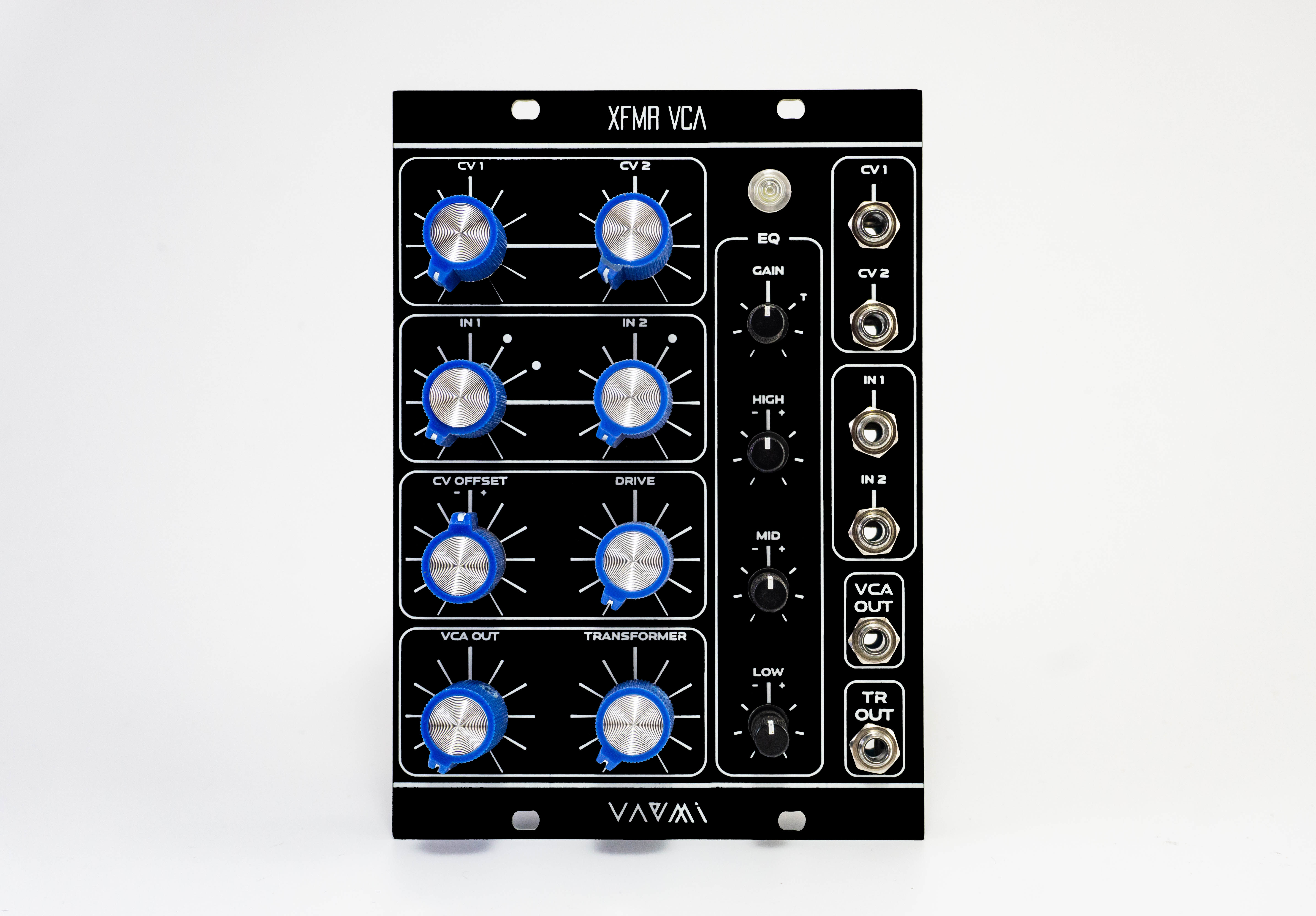XFMR VCA | Voltage Controlled Amplifier with Transformer | Eurorack
XFMR VCA is an amplifier module in the Eurorack format. It is voltage-controlled, linear, and features op-amp and audio transformer output options, as well as saturation-clipping properties. It has a width of 18HP, and it can be used with all synthesizers and allows you to control the level of the sound (amplitude).
XFMR VCA has a 2-channel mixer. You can mix a channel that is not included in filtering in your patch or a sound such as osc, noise into the 2nd input of the VCA. The CV Offset knob sends a DC constant voltage to the VCA, allowing the VCA to remain permanently open and can be used without any CV input. The 0 point of the CV Offset knob is in the center. When you turn the knob to the right, it can add positive offset voltage and when you turn it to the left, it can add negative offset voltage. With the negative voltage, you can shift the offset of the CV signals, that is, the 0 point, in the desired direction by the desired amount. At the same time, moving the CV offset knob in the negative direction provides a great advantage in AM. When the CV Offset knob is wide open in the positive direction, the volume level will increase more and more with the voltages you add from the CV inputs.When the headroom is filled, the VCA will begin to saturate. This saturation is a feature we love and is quite musical. XFMR VCA has two CV inputs. The CV inputs and the VCA's response are completely linear. The VCA can open and close very quickly. It allows for more detailed use with fast and high-quality Envelope Generators. By default, when you input an Envelope Generator into the first CV input, you still have a 2nd CV input as an advantage. Here, you can input a 2nd Envelope Generator signal for various reasons such as LFO, Random CV signals, side-chain, and more.
If we talk about the diagram of the XFMR VCA, it includes an Input Mixer, VCA, Drive, EQ Input Gain, EQ, and two different outputs, such as the Op-Amp output (VCA Out) or the Transformer output (TR Out). When you exceed headroom in VCA, the core of the audio transformer will start saturating after saturation. At the end of the chain, there are attenuator knobs for the Op-amp and Transformer. The outputs have a maximum of ±5V (10Vpp).
Preamplifiers used in studios are equipment that can raise microphone or line level signals smoothly, without altering the sound, and without adding noise. However, when recording analog synthesizers, we don't aim to raise the output, rather we aim to lower it due to their high output levels. You can continue to use the high output levels in your synthesizer patch in any module you want, such as a filter or reverb module, by using it as a modular level. When you use it at a low output level, you can record to any AD Converter of your choice without a preamplifier in between.
The XFMR VCA has an EQ stage before the Transformer and Op-Amp. This EQ stage has an input Gain knob. The knob is at the 12 o'clock position, or the center point, when using the Op-Amp output. When using the Transformer output, the center point of the Gain is marked with a "T" letter. The EQ has 3 bands, and each band's frequencies can be increased or decreased in decibels. The bands are divided into Low, Mid, and High. The Low band boosts or cuts 150hz, the Mid band boosts or cuts 1Khz, and the High band boosts or cuts 8Khz, with a wide curve. When finalizing your patch, an EQ stage in your patches will provide great flexibility and in multi-channel patches will provide a cleaner sound.
XFMR VCA has a white LED on it, which shows the output and audio signal of the VCA.
In conclusion, XFMR VCA is AC Coupled and is designed for audio signals only. It is mostly used at the end of the chain as a VCA module. You can use it to add saturation, harmonics, and EQ to your patch when using sine wave and through zero FM techniques with Osi-Op. You can also use it for clean ranges if you prefer. This wide range will be the options you love and relax you.
In addition, XFMR VCA has an expander and can be expanded up to 3 channels. With the expander, you can have 2 more exponential VCA channels and use them for frequency modulation of oscillators or other various patches.
Features
- Transformer and Op-Amp Output Stages
- Linear VCA
- 2 Audio Inputs
- 2 CV Inputs
- Saturation and Distortion
- 3 Different Distortion Types
- 3 Band EQ
- Amplitude Modulation (AM)
- AC Coupled
- 2 Channel Exponential VCA Expander
XFMR VCA : Short Review : Vaemi (Eurorack)
XFMR VCA : Introduction : Vaemi (Eurorack)
XFMR VCA : Inputs, VCA & TR OUT : Vaemi (Eurorack)
XFMR VCA : Gain Management, Drive Section & Saturation : Vaemi (Eurorack)
XFMR VCA : CV Inputs & Eq Section : Vaemi (Eurorack)
XFMR VCA : with Sequencer & Osi-Op : Vaemi (Eurorack)
XFMR VCA : Amplitude Modulation (AM) : Vaemi (Eurorack)
18HP

